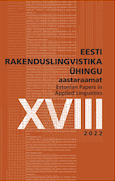ASSESSING EARLY COMPOSITIONALITY OF RUSSIAN VERB DERIVATIVES IN L1 ACQUISITION WITH KENDALL RANK CORRELATION COEFFICIENT
ASSESSING EARLY COMPOSITIONALITY OF RUSSIAN VERB DERIVATIVES IN L1 ACQUISITION WITH KENDALL RANK CORRELATION COEFFICIENT
Author(s): Maria D. Voeikova, Anastasia Glawion, Kira BaydaSubject(s): Morphology, Semantics, Language acquisition, Eastern Slavic Languages
Published by: Eesti Rakenduslingvistika Ühing (ERÜ)
Keywords: derivation; Russian verb; language acquisition; Kendall Rank Correlation Coefficient; L1; Russian;
Summary/Abstract: This paper studies children’s sensitivity to derivational patterns of Russian verbs reflected in the speech data of two boys (ages 1;5–2;8 and 1;7–3;0 respectively). Kendall rank correlation coefficient (KRCC) analysis of three verb groups – morphologically unrelated (elementary), morphologically and semantically related (derived), and morphologically related but semantically opaque verbs – demonstrates that the number and share of derived verbs steadily increases over time, whereas both elementary and semantically opaque verbs behave differently under varying conditions. KRCC applied to child-directed speech did not show any significant increase for any verb groups, reflecting their stable general distribution in adult speech. This means that children are sensitive to morphological distinctions between the respective groups. We discuss the use of KRCC for child language research and the role of derivational patterns in the acquisition of the Russian verb.
Journal: Eesti Rakenduslingvistika Ühingu aastaraamat
- Issue Year: 2022
- Issue No: 18
- Page Range: 325-343
- Page Count: 19
- Language: English

